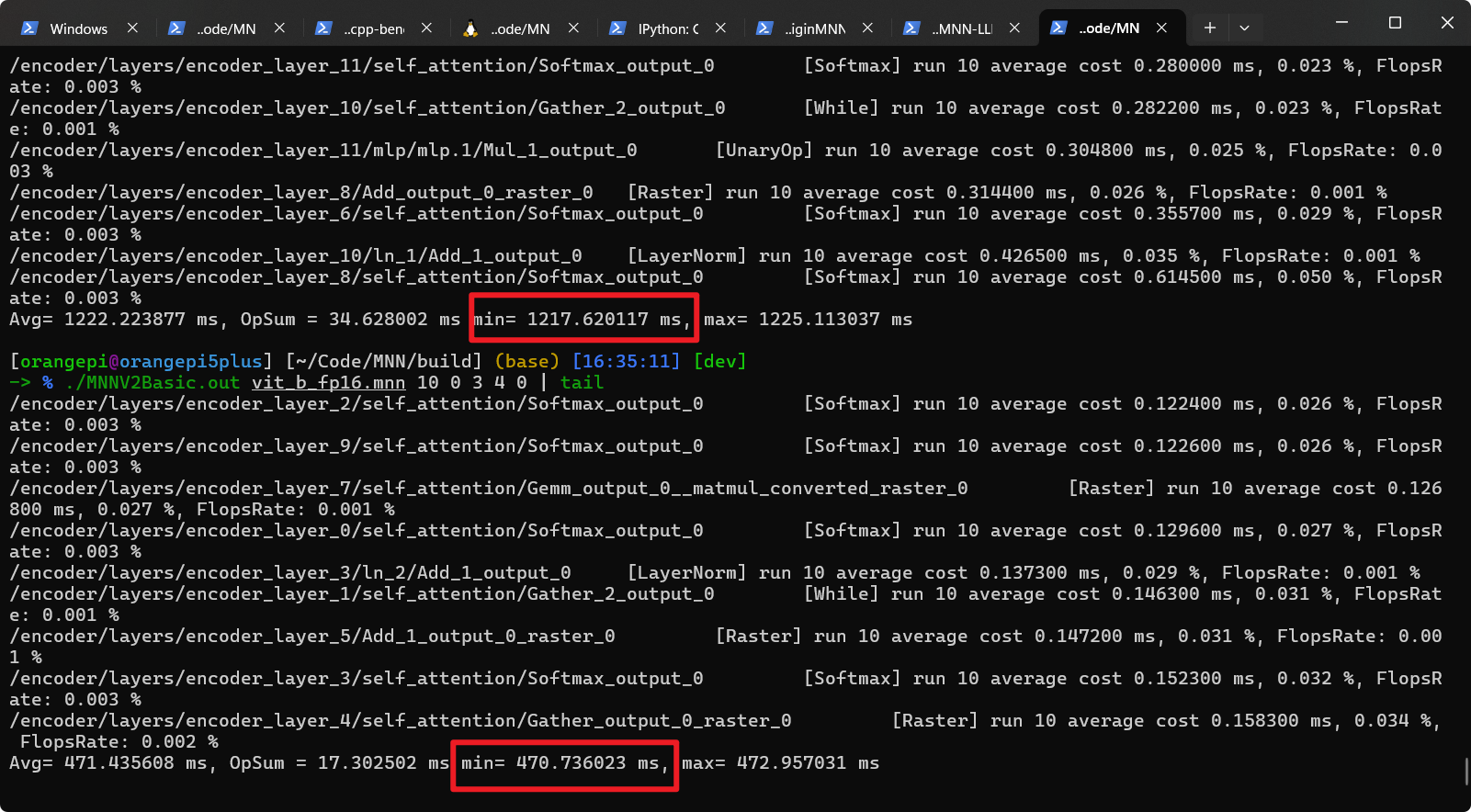1
2
3
4
5
6
7
8
9
10
11
12
13
14
15
16
17
18
19
20
21
22
23
24
25
26
27
28
29
30
31
32
33
34
35
36
37
38
39
40
41
42
43
44
45
46
47
48
49
50
51
52
53
54
55
56
57
58
59
60
61
62
63
64
65
66
67
68
69
70
71
72
73
74
75
76
77
78
79
80
81
82
83
84
85
86
87
88
89
90
91
92
93
94
95
96
97
98
99
100
101
102
103
104
105
106
107
108
109
110
111
112
113
114
115
116
117
118
119
120
121
122
123
124
125
126
127
128
129
130
131
132
133
134
135
136
137
138
139
140
141
142
143
144
145
146
147
148
149
150
151
152
153
154
155
156
157
158
159
160
161
162
163
164
165
166
167
168
169
170
171
172
173
174
175
176
177
178
179
180
181
182
183
184
185
186
187
188
189
190
191
192
193
194
195
196
197
198
199
200
201
202
203
204
205
206
207
208
209
210
211
212
213
214
215
216
217
218
219
220
221
222
223
224
225
226
227
228
229
230
231
232
233
234
235
236
237
238
239
240
241
242
243
244
|
Backend::MemObj* OpenCLBackend::onAcquire(const Tensor* nativeTensor, StorageType storageType) {
#ifdef LOG_VERBOSE
MNN_PRINT("Start OpenCLBackend::onAcquireBuffer !\n");
#endif
auto tensorShape = OpenCL::tensorShapeFormat(nativeTensor);
int N = tensorShape.at(0);
int H = tensorShape.at(1);
int W = tensorShape.at(2);
int C = tensorShape.at(3);
#ifdef LOG_VERBOSE
MNN_PRINT("OpenCLBackend::onAcquireBuffer: NHWC:[%d, %d, %d, %d]\n", N, H, W, C);
#endif
#ifndef MNN_OPENCL_BUFFER_CLOSED
if(mOpenCLRuntime->getGpuMemType() == BUFFER) {
size_t size;
if (nativeTensor->dimensions() >= 2) {
auto alignC = ROUND_UP(C, 8);
auto hR = ROUND_UP(H + 3, 4) - H;
auto wR = ROUND_UP(W + 3, 4) - W;
size = N * alignC * W * H;
size = size + hR * W * 4 + wR * 4;
} else {
size = nativeTensor->elementSize();
size = ROUND_UP(size, 4);
}
if (mOpenCLRuntime->isSupportedIntelSubgroup()) {
int cPack = TensorUtils::getTensorChannelPack(nativeTensor);
auto pads = TensorUtils::getDescribe(nativeTensor)->mPads;
size_t imageWidth = (size_t) ROUND_UP(UP_DIV(C, cPack), 2) * ROUND_UP(pads.left + W + pads.right, 4);
size_t imageHeight = (size_t)N * H;
size = imageWidth*imageHeight*cPack;
}
cl_channel_type dataType = CL_FLOAT;
if (getOpenCLRuntime()->isSupportedFP16()) {
dataType = CL_HALF_FLOAT;
}
if (storageType == DYNAMIC_SEPERATE) {
auto buffer = mBufferPool->alloc(size*
(dataType==CL_HALF_FLOAT?sizeof(half_float::half):sizeof(float)), true);
((Tensor*)nativeTensor)->buffer().device = (uint64_t)buffer;
return new CLMemReleaseBuffer(buffer, mBufferPool.get());
}
if (storageType == DYNAMIC) {
auto buffer = mBufferPool->alloc(size*
(dataType==CL_HALF_FLOAT?sizeof(half_float::half):sizeof(float)));
((Tensor*)nativeTensor)->buffer().device = (uint64_t)buffer;
return new CLMemReleaseBuffer(buffer, mBufferPool.get());
}
MNN_ASSERT(storageType == STATIC);
#ifdef MNN_LOW_MEMORY
if ((nativeTensor->getType().code == halide_type_int) &&
(nativeTensor->getType().bits == 8 || nativeTensor->getType().bits == 4)) {
size_t alloc_size = size;
if (nativeTensor->getType().bits == 4) {
alloc_size = size / 2;
}
auto buffer = mStaticBufferPool->alloc(alloc_size);
((Tensor*)nativeTensor)->buffer().device = (uint64_t)buffer;
return new CLMemReleaseBuffer(buffer, mStaticBufferPool.get());
}
#endif
auto buffer = mStaticBufferPool->alloc(size*
(dataType == CL_HALF_FLOAT ? sizeof(half_float::half) : sizeof(float)));
((Tensor*)nativeTensor)->buffer().device = (uint64_t)buffer;
return new CLMemReleaseBuffer(buffer, mStaticBufferPool.get());
}
else
#endif
{
size_t imageWidth = (size_t) (UP_DIV(C, 4) * W);
size_t imageHeight = (size_t)N * H;
cl_channel_type dataType = CL_HALF_FLOAT;
if (mPrecision == BackendConfig::Precision_High) {
dataType = CL_FLOAT;
}
if (storageType == DYNAMIC_SEPERATE) {
auto image = mImagePool->alloc(imageWidth, imageHeight, dataType, true);
((Tensor*)nativeTensor)->buffer().device = (uint64_t)image;
return new CLMemReleaseImage(image, mImagePool.get());
}
if (storageType == DYNAMIC) {
auto image = mImagePool->alloc(imageWidth, imageHeight, dataType);
((Tensor*)nativeTensor)->buffer().device = (uint64_t)image;
return new CLMemReleaseImage(image, mImagePool.get());
}
MNN_ASSERT(storageType == STATIC);
auto image = mStaticImagePool->alloc(imageWidth, imageHeight, dataType);
((Tensor*)nativeTensor)->buffer().device = (uint64_t)image;
return new CLMemReleaseImage(image, mStaticImagePool.get());
}
}
void* OpenCLBackend::onMapTensor(Tensor::MapType mtype, Tensor::DimensionType dtype, const Tensor* srcTensor) {
auto needSize = srcTensor->size();
clearRecord();
#ifdef MNN_OPENCL_SVM_ENABLE
auto svm_cap_ = mOpenCLRuntime->getSvmCapabilities();
bool use_svm = (svm_cap_ & CL_DEVICE_SVM_FINE_GRAIN_BUFFER);
use_svm |= ((svm_cap_ & CL_DEVICE_SVM_COARSE_GRAIN_BUFFER) && mOpenCLRuntime->getGpuType() == ADRENO);
mUseSvm = (mOpenCLRuntime->getCLVersion() > 1.99f && use_svm);
if(mUseSvm) {
svmPtr = allocMapTensorMemory(needSize, true, svm_cap_);
if(mtype == Tensor::MAP_TENSOR_READ) {
MNN::Tensor tmpTensor(srcTensor, dtype, false);
tmpTensor.buffer().device = (uint64_t)svmPtr;
MNN_DATA_FORMAT format_type = MNN_DATA_FORMAT_NCHW;
if(dtype == MNN::Tensor::TENSORFLOW) {
format_type = MNN_DATA_FORMAT_NHWC;
} else if(dtype == MNN::Tensor::CAFFE_C4) {
format_type = MNN_DATA_FORMAT_NC4HW4;
}
mCLRuntime->convertFromDevice(srcTensor, &tmpTensor, format_type, true);
}
if(svm_cap_ & CL_DEVICE_SVM_FINE_GRAIN_BUFFER) {
mOpenCLRuntime->commandQueue().finish();
return svmPtr;
}
auto map_flag = CL_MAP_WRITE;
if(mtype == Tensor::MAP_TENSOR_READ) {
map_flag = CL_MAP_READ;
}
cl_int res = clEnqueueSVMMap(mOpenCLRuntime->commandQueue().get(), true, map_flag, svmPtr, needSize, 0, nullptr, nullptr);
MNN_CHECK_CL_SUCCESS(res, "svm_map")
return svmPtr;
}
#endif
svmPtr = allocMapTensorMemory(needSize, false);
if(mtype == Tensor::MAP_TENSOR_READ) {
MNN::Tensor tmpTensor(srcTensor, dtype, false);
tmpTensor.buffer().host = (uint8_t *)svmPtr;
onCopyBuffer(srcTensor, &tmpTensor);
}
return svmPtr;
}
bool OpenCLBackend::onUnmapTensor(Tensor::MapType mtype, Tensor::DimensionType dtype, const Tensor* dstTensor, void* mapPtr) {
#ifdef MNN_OPENCL_SVM_ENABLE
auto svm_cap_ = mOpenCLRuntime->getSvmCapabilities();
if(mUseSvm) {
if(!(svm_cap_ & CL_DEVICE_SVM_FINE_GRAIN_BUFFER)) {
cl_int res = clEnqueueSVMUnmap(mOpenCLRuntime->commandQueue().get(), svmPtr, 0, nullptr, nullptr);
MNN_CHECK_CL_SUCCESS(res, "svm_unmap")
}
if(mtype == Tensor::MAP_TENSOR_WRITE) {
MNN::Tensor interTensor(dstTensor, dtype, false);
interTensor.buffer().device = (uint64_t)svmPtr;
MNN_DATA_FORMAT format_type = MNN_DATA_FORMAT_NCHW;
if(dtype == MNN::Tensor::TENSORFLOW) {
format_type = MNN_DATA_FORMAT_NHWC;
} else if(dtype == MNN::Tensor::CAFFE_C4) {
format_type = MNN_DATA_FORMAT_NC4HW4;
}
mCLRuntime->convertToDevice(&interTensor, dstTensor, format_type, true);
}
mOpenCLRuntime->commandQueue().finish();
return true;
}
#endif
if(mtype == Tensor::MAP_TENSOR_WRITE) {
MNN::Tensor srcTensor(dstTensor, dtype, false);
srcTensor.buffer().host = (uint8_t *)svmPtr;
onCopyBuffer(&srcTensor, dstTensor);
}
return true;
}
void ConvBufExecution::setConv1x1WeightBuffer(int packCout, int packCin, const float* filterDataPtr) {
cl_int res;
std::shared_ptr<Tensor> filterBuffer(Tensor::createDevice<float>({ROUND_UP(mOutputChannel, 8), ROUND_UP(mInputChannel, packCin), mKernelWidth, mKernelHeight}));
int buffer_size = filterBuffer->elementSize();
if(mOpenCLBackend->getOpenCLRuntime()->isSupportedFP16()) {
buffer_size *= sizeof(half_float::half);
} else {
buffer_size *= sizeof(float);
}
mKernelBuffer.reset(new cl::Buffer(mOpenCLBackend->getOpenCLRuntime()->context(), CL_MEM_READ_WRITE | CL_MEM_ALLOC_HOST_PTR, buffer_size));
auto kernelBufferPtr = mOpenCLBackend->getOpenCLRuntime()->commandQueue().enqueueMapBuffer(*(mKernelBuffer.get()), true, CL_MAP_WRITE, 0, buffer_size, nullptr, nullptr, &res);
if(kernelBufferPtr != nullptr && res == CL_SUCCESS){
::memset(kernelBufferPtr, 0, buffer_size);
for(int o = 0; o < mOutputChannel; o++){
for(int i = 0 ; i < mInputChannel; i++){
int bufferIdx = (o/packCout) * ROUND_UP(mInputChannel, packCin)*packCout + (i/packCin)*packCin*packCout + (o%packCout)*packCin + (i%packCin);
int filterIdx = o*mInputChannel + i;
if(mOpenCLBackend->getOpenCLRuntime()->isSupportedFP16()){
((half_float::half*)kernelBufferPtr)[bufferIdx] = (half_float::half)(filterDataPtr[filterIdx]);
}else{
((float*)kernelBufferPtr)[bufferIdx] = (float)(filterDataPtr[filterIdx]);
}
}
}
}else{
MNN_ERROR("Map error ptrCL == nullptr \n");
MNN_ASSERT(false);
}
mOpenCLBackend->getOpenCLRuntime()->commandQueue().enqueueUnmapMemObject(*(mKernelBuffer.get()), kernelBufferPtr);
}
|
